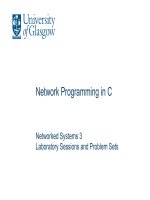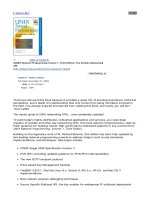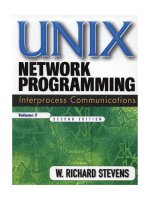Addison wesley c plus plus network programming volume 2 systematic reuse with ACE and frameworks ISBN 0201795256
Bạn đang xem bản rút gọn của tài liệu. Xem và tải ngay bản đầy đủ của tài liệu tại đây (4.24 MB, 587 trang )
•
TableofContents
C++NetworkProgramming,Volume2:
SystematicReusewithACEandFrameworks
ByDouglasC.Schmidt,StephenD.Huston
Publisher
:AddisonWesley
PubDate
:October29,2002
ISBN
:0-201-79525-6
Pages
:384
Doyouneedtodevelopflexiblesoftwarethatcanbecustomizedquickly?
Doyouneedtoaddthepowerandefficiencyofframeworkstoyour
software?TheADAPTIVECommunicationEnvironment(ACE)isan
open-sourcetoolkitforbuildinghigh-performancenetworkedapplications
andnext-generationmiddleware.ACE'spowerandflexibilityarisefrom
object-orientedframeworks,usedtoachievethesystematicreuseof
networkedapplicationsoftware.ACEframeworkshandlecommon
networkprogrammingtasksandcanbecustomizedusingC++language
featurestoproducecompletedistributedapplications.
C++NetworkProgramming,Volume2,focusesonACEframeworks,
providingthoroughcoverageoftheconcepts,patterns,andusagerules
thatformtheirstructure.Thisbookisapracticalguidetodesigning
object-orientedframeworksandshowsdevelopershowtoapply
frameworkstoconcurrentnetworkedapplications.C++Networking,
Volume1,introducedACEandthewrapperfacades,whicharebasic
networkcomputingingredients.Volume2explainshowframeworksbuild
onwrapperfacadestoprovidehigher-levelcommunicationservices.
WrittenbytwoexpertsintheACEcommunity,thisbookcontains:
AnoverviewofACEframeworks
Designdimensionsfornetworkedservices
DescriptionsofthekeycapabilitiesofthemostimportantACE
frameworks
NumerousC++codeexamplesthatdemonstratehowtouseACE
frameworks
C++NetworkProgramming,Volume2,teacheshowtouseframeworks
towritenetworkedapplicationsquickly,reducingdevelopmenteffortand
overhead.ItwillbeaninvaluableassettoanyC++developerworkingon
networkedapplications.
•
TableofContents
C++NetworkProgramming,Volume2:
SystematicReusewithACEandFrameworks
By
DouglasC.Schmidt,StephenD.Huston
Publisher
:AddisonWesley
PubDate
:October29,2002
ISBN
:0-201-79525-6
Pages
:384
Copyright
Foreword
AboutThisBook
IntendedAudience
StructureandContent
RelatedMaterial
Acknowledgments
Chapter1.
Object-OrientedFrameworksforNetworkProgramming
Section1.1.
AnOverviewofObject-OrientedFrameworks
Section1.2.
ComparingSoftwareDevelopmentandReuseTechniques
Section1.3.
ApplyingFrameworkstoNetworkProgramming
Section1.4.
ATourthroughtheACEFrameworks
Section1.5.
Example:ANetworkedLoggingService
Section1.6.
Summary
Chapter2.
ServiceandConfigurationDesignDimensions
Section2.1.
ServiceandServerDesignDimensions
Section2.2.
ConfigurationDesignDimensions
Section2.3.
Summary
Chapter3.
TheACEReactorFramework
Section3.1.
Overview
Section3.2.
TheACE_Time_ValueClass
Section3.3.
TheACE_Event_HandlerClass
Section3.4.
TheACETimerQueueClasses
Section3.5.
TheACE_ReactorClass
Section3.6.
Summary
Chapter4.
ACEReactorImplementations
Section4.1.
Overview
Section4.2.
TheACE_Select_ReactorClass
Section4.3.
TheACE_TP_ReactorClass
Section4.4.
TheACE_WFMO_ReactorClass
Section4.5.
Summary
Chapter5.
TheACEServiceConfiguratorFramework
Section5.1.
Overview
Section5.2.
TheACE_Service_ObjectClass
Section5.3.
TheACE_Service_RepositoryClasses
Section5.4.
TheACE_Service_ConfigClass
Section5.5.
Summary
Chapter6.
TheACETaskFramework
Section6.1.
Overview
Section6.2.
TheACE_Message_QueueClass
Section6.3.
TheACE_Task_Class
Section6.4.
Summary
Chapter7.
TheACEAcceptor-ConnectorFramework
Section7.1.
Overview
Section7.2.
TheACE_Svc_HandlerClass
Section7.3.
TheACE_AcceptorClass
Section7.4.
TheACE_ConnectorClass
Section7.5.
Summary
Chapter8.
TheACEProactorFramework
Section8.1.
Overview
Section8.2.
TheAsynchronousI/OFactoryClasses
Section8.3.
TheACE_HandlerClass
Section8.4.
TheProactiveAcceptor-ConnectorClasses
Section8.5.
TheACE_ProactorClass
Section8.6.
Summary
Chapter9.
TheACEStreamsFramework
Section9.1.
Overview
Section9.2.
TheACE_ModuleClass
Section9.3.
TheACE_StreamClass
Section9.4.
Summary
Glossary
Bibliography
Copyright
Manyofthedesignationsusedbymanufacturersandsellersto
distinguishtheirproductsareclaimedastrademarks.Wherethose
designationsappearinthisbook,andAddison-Wesleywasawareofa
trademarkclaim,thedesignationshavebeenprintedwithinitialcapital
lettersorinallcapitals.
Theauthorsandpublisherhavetakencareinthepreparationofthis
book,butmakenoexpressedorimpliedwarrantyofanykindand
assumenoresponsibilityforerrorsoromissions.Noliabilityisassumed
forincidentalorconsequentialdamagesinconnectionwithorarisingout
oftheuseoftheinformationorprogramscontainedherein.
Thepublisheroffersdiscountsonthisbookwhenorderedinquantityfor
bulkpurchasesandspecialsales.Formoreinformation,pleasecontact:
U.S.CorporateandGovernmentSales(800)382-3419
ForsalesoutsideoftheU.S.,pleasecontact:InternationalSales
(317)581-3793
VisitAddison-WesleyontheWeb:www.awprofessional.com
LibraryofCongressCataloging-in-PublicationDataSchmidt,DouglasC.
C++networkprogramming/DouglasC.Schmidt,StephenD.Huston.
p.cm.
Includesbibliographicalreferencesandindex.
Contents:Vol.2.SystematicreusewithACEandframeworks.
(v.2:pbk.)
1.C++(Computerprogramlanguage)2.Object-orientedprogramming
(Computerscience)3.Computernetworks.I.Huston,StephenD.II.Title.
QA76.73.C153S3682002
005.2'762—dc21
2001053345
Copyright©2003byPearsonEducation,Inc.
Allrightsreserved.Nopartofthispublicationmaybereproduced,stored
inaretrievalsystem,ortransmitted,inanyform,orbyanymeans,
electronic,mechanical,photocopying,recording,orotherwise,withoutthe
priorconsentofthepublisher.PrintedintheUnitedStatesofAmerica.
PublishedsimultaneouslyinCanada.
Forinformationonobtainingpermissionforuseofmaterialfromthis
work,pleasesubmitawrittenrequestto:PearsonEducation,Inc.
RightsandContractsDepartment75ArlingtonStreet,Suite300
Boston,MA02116
Fax:(617)848-7047
Textprintedonrecycledpaper12345678910—MA—0605040302
Firstprinting,October2002
Foreword
TheADAPTIVECommunicationEnvironment(ACE)toolkithasachieved
enormoussuccessintheareaofmiddlewarefornetworkedcomputing.
Duetoitsflexibility,performance,platformcoverage,andotherkey
properties,ACEenjoysbroadacceptancebythenetworkedapplication
softwarecommunity,asevidencedbyitsuseinthousandsof
applications,inscoresofcountries,andindozensofdomains.ACEhas
alsoreceivedconsiderableattentionbeyondthemiddlewarecommunity
sinceit'sanopen-sourcerolemodelforhigh-qualityandwell-designed
pattern-orientedsoftwarearchitectures.
ButwhyisACEsosuccessful?Addressingthisquestionproperlytakes
somethought.Tostartoff,let'sreconsidertheForewordfromC++
NetworkProgramming:MasteringComplexitywithACEandPatterns
(C++NPv1)andresumethemasstransitanalogypresentedtherebymy
colleagueSteveVinoski.Steve'srightthatahigh-qualitymasstransit
systemconsistsofmorethanjustaircraft,airports,trains,trainstations,
andrails.Italsoneedslessobviousinfrastructure,suchasscheduling,
routing,ticketing,maintenance,andmonitoring.Butevenacomplete
collectionofingredientsisstillnotsufficienttodevelopaneffectivemass
transitsystem.Arrangingtheseingredientssotheyseamlesslyfulfilltheir
primaryobjective—fastandreliabletransportationofpeople—isequally
important.Wouldyouuseamasstransitsystemwhoseticketingwas
locatedinatrainmaintenancelocationoranairporthangar,orwhose
plannedandactualschedulingandroutingweren'tavailabletothe
public?Idoubtit!
Thesuccessofmasstransitsystemsdependsonmorethanthe
knowledgeoftheinfrastructurepartsthatareprovided—itdependson
howthesedifferentpartsmustbeconnectedandintegratedwiththeir
environment.Thisknowledgeenablesarchitectsofmasstransitsystems
tointegrateindividualpartsintohigher-levelbuildingblocksandto
connectthesebuildingblockseffectively.Forexample,ticketing,
informationpoints,baggageoffices,andboardingareintegratedintrain
stationslocatedatcitycentersormajorsuburbancenters.Likewise,
airportsareoftenlocatednearlargecitiesandconnectedbyfrequent
expresstrains.
Evenmasstransitcentersthemselvesarearrangedsothatactivitiescan
beperformedeffectively.Forexample,whenyouenteratrainstationor
airportviathemainentrance,youfindticketagents,informationcenters,
andtimetables.Youalsofindshopstosatisfyyourtravelneeds.Asyou
enterthemaintrainhallorairportconcourse,youfindotherinformation
centers,up-to-dateschedulinginformation,andtheplatformsandgates
forboardingthetrainsandplanes.Masstransitcentersthusnotonly
provideallnecessaryservicestobeginandendajourney,theyalso
organizetheirinternal"controlflows"effectively.Whilethecorestructures
andcontrolflowsinmosttrainstationsandairportsaresimilar,their
concreterealizationcandifferwidely.Yetweallrecognizethesemass
transitcenterpatternsimmediatelysincetheyfollowkeyinvariantsthat
we'velearnedthroughyearsofexperience.
Sowhat'stheconnectionbetweensuccessfulmasstransitsystemdesign
andthesuccessofACE?Theanswerissimple:Inadditiontothebasic
networkcomputingingredients(thewrapperfacadesthatDougand
SteveintroducedinC++NPv1),ACEalsoincludesusefulobject-oriented
frameworksthatbuilduponthesewrapperfacadesandprovideuseful
higher-levelcommunicationservices,suchaseventdemultiplexingand
dispatching,connectionmanagement,serviceconfiguration,concurrency,
andhierarchicallylayeredstreamprocessing.TheACEframework
servicessatisfymanynetworkedsoftwareneedsbyorganizingthe
structuresandinternalcontrolflowsofyourapplicationseffectivelyvia
keypatternslearnedthroughyearsofexperience.
TheACEframeworksofferyouanumberofimportantbenefits:
Youneedn'tdevelopthecapabilitiesprovidedbyACE,whichwill
saveconsiderabletimeandeffort.Youcanthereforefocusonyour
keyresponsibility:implementingtheapplicationfunctionalityrequired
byyourcustomersandendusers.
TheACEframeworksreifytheextensivenetworkprogramming
expertisethatDoug,Steve,andtheircolleagueshavegainedover
severaldecades.Inparticular,theACEframeworksefficiently
implementthecanonicalclasses,classrelationships,andcontrol
flowscommontonetworkedapplications.TheACEframeworksare
testedregularlybythousandsofusersfromaroundtheworld,which
hasyieldedmanyusefulcorrectionsandimprovements.AsanACE
user,youcandirectlyleveragethecorrectness,effectiveness,and
efficiencyoftheACEframeworksinyourapplications.
Aframeworkisn'taframeworkifitcan'tbeadaptedtospecificuser
needs.ThismeansyoucanadapttheACEframeworksatkeypoints
ofvariationinnetworkedapplications.Forexample,theACE
Reactorframeworkcanbeadaptedtousedifferentevent
demultiplexerfunctions,suchasWaitForMultipleObjects()
orselect().Likewise,theACEAcceptor-Connectorframework
canbeconfiguredwithdifferentIPCmechanisms.Whilethis
adaptabilityisbeneficialbyitself,ACEgoesastepfurther:formany
adaptationsyoucanconfigurethedesiredstrategiesfromavailable
andinterchangeableimplementations.InadditiontothedifferentReactorimplementationsmentionedabove,forinstance,ACEprovides
wrapperfacadesforvariousIPCmechanisms,suchastheSockets,
SSL,TLI,andsharedmemory,thathelptoconfiguretheACE
Acceptor-Connectorframeworkforspecificplatformsand
applications.
Lastbutnotleast,theACEframeworksdon'texistinisolation.You
canthereforecombinetheminnovelwaystocreatenetworked
applicationsandentirelynewtypesofmiddleware.Forexample,you
canintegratetheReactorframeworkwiththeAcceptor-Connector
frameworktoseparateconnectionestablishmentfromservice
processingfunctionalityinevent-drivenapplications.Youcan
likewiseintroducevariousformsofconcurrencyintoyour
applicationsusingtheACETaskframework.
Asaresultofadvisingandleadingmanysoftwareprojectsoverthe
years,I'vefoundthatACEgreatlysimplifiesthetaskofemploying
reusablemiddlewarethatcanbecustomizedreadilytomeettheneedsof
networkedapplications.Notallnetworkedapplicationsneedheavyweight
middleware,suchasapplicationservers,webservices,andcomplex
componentmodels.Yetmostnetworkedapplicationscanbenefitfrom
portableandefficienthostinfrastructuremiddlewarelikeACE.This
flexibilityisthecoreofACE'ssuccesssinceyouneedn'tcommittoan
entiremiddlewaresuiteifyoudon'tuseallofit.Instead,youcancombine
justtheessentialACEmiddlewareclassesyouneedtocompose
applicationsthataresmall,butaspowerfulasnecessary.Forthisreason,
IpredictthatACEwillstillbewidelyusedlongaftertheinfluenceof
today'sheavyweightmiddlewarehaswaned.
ACE'stremendousflexibilityalsoneedn'tleadtoaseaofincompatible
middlewareimplementations.Forexample,ifyoubuildanembedded
systemthatspeakstheCORBAInternetinter-ORBprotocol(IIOP)tothe
outsideworld,youcanuseTheACEORB(TAO),whichisaCORBAcompliant,open-source,real-timeobjectrequestbroker(ORB)builtusing
theACEwrapperfacadesandframeworks.IfCORBAisoverkillforyour
applicationneeds,however,youcanbuildcustom,yetinteroperable,
middlewareusingtheappropriateACEclasses.Bothsolutionscanbe
basedonthesamecorestructuresandprotocols,suchastheACE
CommonDataRepresentation(CDR)classesanditsTCP/IPSocket
wrapperfacades.Theycanthereforecommunicateseamlesslywithone
another,justasyoucantakeatrainfromParistoIstanbul—thefamous
OrientExpress—andtravelthroughmanyEuropeancountrieswithout
havingtochangetrainsduetoincompatiblerailroadnetworks.
AsSteveVinoskiandIhavepointedout,therearemanysimilarities
betweenhigh-qualitymasstransitsystemsandhigh-qualitynetworking
middleware.TomeandthousandsofotherC++developersaroundthe
world,ACEisthetoolkitforbuildingthelatter!Aftersayingsomanygood
thingsaboutACE,however,let'sreturntothemainintentofthis
foreword:introducingthesecondvolume(C++NPv2)oftheC++Network
Programmingseries.Aswithallsoftwaretechnologiesandmiddleware,
themoreyouunderstandyourtools,thebetteryou'llbeabletoapply
them.ItturnsoutthatusingACEinyourapplicationsisjustoneaspectof
improvingyournetworkedsoftware.TobenefitsignificantlyfromACE's
manyadvantages,youthereforealsoneedasoundunderstandingofthe
coreconcepts,patterns,andusagerulesthatunderlieitspowerful
frameworks.
Foryears,acommonwaytolearnACEinvolvedstudyingitscode,
comments,andexampleapplications.Clearly,thisprocesswastime
consuminganderrorprone.Moreover,evenaftermanagingtoreadthe
severalhundredthousandlinesofC++codeinACE,itwaseasytomiss
theforestforthetrees.AstheGreekphilosopherThucydidesnotedtwo
millenniaago:"Amanwhohastheknowledgebutlacksthepowerto
clearlyexpresshimselfisnobetteroffthanifhehadneveranyideaat
all."
We'rethereforefortunatethatDougandStevefoundtimeintheirbusy
schedulestocreatesuchahigh-qualitybookontheACEframeworks.
C++NPv2explainstheideasandconceptsunderlyingtheACE
frameworksinaneasilyaccessibleformusingthepopularconcurrency
andnetworkingpatternsfromthePOSA[POSA1,POSA2]and"Gangof
Four"[GoF]patternsbooks.Thesepatterns,inturn,reifythoughtfuland
time-provensolutionstocommonnetworkingproblems.Forexample,
theytellyouwhattheproblemsare,whytheseproblemsarehard,what
thesolutionstotheseproblemsare,andwhythesesolutionsappliedto
ACEareofhighquality.Ifyouwantthoroughcoverageofthepatterns
andframeworksinACEthatareshapingthenextgenerationof
networkedapplicationsoftwarethenreadthisbook.I'velearnedmuch
fromitandI'msureyouwilltoo.
FrankBuschmann
SeniorPrincipalEngineer
SiemensCorporateTechnology
Munich,Germany
AboutThisBook
Softwarefornetworkedapplicationsmustpossessthefollowingqualities
tobesuccessfulintoday'scompetitive,fast-pacedcomputingindustry:
Affordability,toensurethatthetotalownershipcostsofsoftware
acquisitionandevolutionarenotprohibitivelyhigh
Extensibility,tosupportsuccessionsofquickupdatesandadditions
toaddressnewrequirementsandtakeadvantageofemerging
markets
Flexibility,tosupportagrowingrangeofmultimediadatatypes,
trafficpatterns,andend-to-endqualityofservice(QoS)requirements
Portability,toreducetheeffortrequiredtosupportapplicationson
heterogeneousOSplatformsandcompilers
Predictabilityandefficiency,toprovidelowlatencytodelaysensitivereal-timeapplications,highperformancetobandwidthintensiveapplications,andusabilityoverlow-bandwidthnetworks,
suchaswirelesslinks
Reliability,toensurethatapplicationsarerobust,faulttolerant,and
highlyavailable
Scalability,toenableapplicationstohandlelargenumbersofclients
simultaneously
Writinghigh-qualitynetworkedapplicationsthatexhibitthesequalitiesis
hard—it'sexpensive,complicated,anderrorprone.Thepatterns,C++
languagefeatures,andobject-orienteddesignprinciplespresentedin
C++NetworkProgramming,Volume1:MasteringComplexitywithACE
andPatterns(C++NPv1)helptominimizecomplexityandmistakesin
networkedapplicationsbyrefactoringcommonstructureandfunctionality
intoreusablewrapperfacadeclasslibraries.Thekeybenefitsofreuse
willbelost,however,iflargepartsoftheapplicationsoftwarethatuses
theseclasslibraries—orworse,theclasslibrariesthemselves—mustbe
rewrittenforeachnewproject.
Historically,manynetworkedapplicationsoftwareprojectsbeganby
1. Designingandimplementingdemultiplexinganddispatching
infrastructuremechanismsthathandletimedeventsandI/Oon
multiplesockethandles
Addingserviceinstantiationandprocessingmechanismsatopthe
demultiplexinganddispatchinglayer,alongwithmessagebufferingand
queueingmechanisms
Implementinglargeamountsofapplication-specificcodeusingthisad
hochostinfrastructuremiddleware
Thisdevelopmentprocesshasbeenappliedmanytimesinmany
companies,bymanyprojectsinparallel.Evenworse,it'sbeenappliedby
thesameteamsinaseriesofprojects.Regrettably,thiscontinuous
rediscoveryandreinventionofcoreconceptsandcodehaskeptcosts
unnecessarilyhighthroughoutthesoftwaredevelopmentlifecycle.This
problemisexacerbatedbytheinherentdiversityoftoday'shardware,
operatingsystems,compilers,andcommunicationplatforms,whichkeep
shiftingthefoundationsofnetworkedapplicationsoftwaredevelopment.
Object-orientedframeworks[FJS99b,FJS99a]areoneofthemost
flexibleandpowerfultechniquesthataddresstheproblemsoutlined
above.Aframeworkisareusable,"semi-complete"applicationthatcan
bespecializedtoproducecustomapplications[JF88].Frameworkshelp
toreducethecostandimprovethequalityofnetworkedapplicationsby
reifyingprovensoftwaredesignsandpatternsintoconcretesourcecode.
Byemphasizingtheintegrationandcollaborationofapplication-specific
andapplication-independentclasses,frameworksenablelargerscale
reuseofsoftwarethancanbeachievedbyreusingindividualclassesor
stand-alonefunctions.
Intheearly1990s,DougSchmidtstartedtheopen-sourceACEprojectto
bringthepowerandefficiencyofpatternsandframeworkstonetworked
applicationdevelopment.AswithmuchofDoug'swork,ACEaddressed
manyreal-worldproblemsfacedbyprofessionalsoftwaredevelopers.
Overthefollowingdecade,hisgroupsattheUniversityofCalifornia,
Irvine;WashingtonUniversity,St.Louis;andVanderbiltUniversity,along
withcontributionsfromtheACEusercommunityandSteveHustonat
Riverace,yieldedaC++toolkitcontainingsomeofthemostpowerfuland
widelyusedconcurrentobject-orientednetworkprogrammingframeworks
intheworld.ByapplyingreusablesoftwarepatternsandalightweightOS
portabilitylayer,theframeworksintheACEtoolkitprovidesynchronous
andasynchronouseventprocessing;concurrencyandsynchronization;
connectionmanagement;andserviceconfiguration,initialization,and
hierarchicalintegration.
ThesuccessofACEhasfundamentallyalteredthewaythatnetworked
applicationsandmiddlewarearedesignedandimplementedonthemany
operatingsystemsoutlinedinSidebar2(page16).ACEisbeingusedby
thousandsofdevelopmentteams,rangingfromlargeFortune500
companiestosmallstartupstoadvancedresearchprojectsatuniversities
andindustrylabs.Itsopen-sourcedevelopmentmodelandselfsupportingcultureissimilarinspiritandenthusiasmtothatdrivingLinus
Torvalds'spopularLinuxoperatingsystem.
ThisbookdescribeshowtheACEframeworksaredesignedandhow
theycanhelpdevelopersnavigatebetweenthelimitationsof
1. Low-levelnativeoperatingsystemAPIs,whichareinflexible
andnonportable
High-levelmiddleware,suchasdistributionmiddlewareandcommon
middlewareservices,whichoftenlackstheefficiencyandflexibilityto
supportnetworkedapplicationswithstringentQoSandportability
requirements
Theskillsrequiredtoproduceandusenetworkedapplicationframeworks
havetraditionallybeenlockedintheheadsofexpertdevelopersorburied
deepwithinthesourcecodeofnumerousprojectsthatarespread
throughoutanenterpriseoranindustry.Neitheroftheselocationsis
ideal,ofcourse,sinceit'stimeconsuminganderrorpronetoreengineer
thisknowledgeforeachnewapplicationorproject.Toaddressthis
problem,thisbookillustratesthekeypatterns[POSA2,POSA1,GoF]
thatunderliethestructureandfunctionalityoftheACEframeworks.Our
coverageofthesepatternsalsomakesiteasiertounderstandthedesign,
implementation,andeffectiveuseoftheopen-sourceACEtoolkititself.
IntendedAudience
Thisbookisintendedfor"handson"C++developersoradvanced
studentsinterestedinunderstandinghowtodesignobject-oriented
frameworksandapplythemtodevelopnetworkedapplications.Itbuilds
uponmaterialfromC++NPv1thatshowshowdeveloperscanapply
patternstomastercomplexitiesarisingfromusingnativeOSAPIsto
programnetworkedapplications.It'sthereforeimportanttohaveasolid
graspofthefollowingtopicscoveredinC++NPv1beforereadingthis
book:
Networkedapplicationdesigndimensions,includingthe
alternativecommunicationprotocolsanddatatransfermechanisms
discussedinChapter1ofC++NPv1
Internetprogrammingmechanisms,suchasTCP/IPconnection
managementanddatatransferAPIs[Ste98]discussedinChapter2
ofC++NPv1
Concurrencydesigndimensions,includingtheuseofprocesses
andthreads,iterativeversusconcurrentversusreactiveservers,and
threadingmodels[Ste99]discussedinChapters5through9of
C++NPv1
Synchronizationtechniquesnecessarytocoordinatethe
interactionsofprocessesandthreadsonvariousOSplatforms
[KSS96,Lew95,Ric97]discussedinChapter10ofC++NPv1
Object-orienteddesignandprogrammingtechniques[Boo94,
Mey97]thatcansimplifyOSAPIsandavoidprogrammingmistakes
throughtheuseofpatterns,suchasWrapperFacade[POSA2]and
Proxy[POSA1,GoF]discussedinChapter3andAppendixAof
C++NPv1
TheACEframeworksarehighlyflexibleandpowerful,dueinlargepartto
theiruseofC++languagefeatures[Bja00].Youshouldthereforebe
familiarwithC++classinheritanceandvirtualfunctions(dynamicbinding)
aswellastemplates(parameterizedtypes)andthemechanismsyour
compiler(s)offertoinstantiatethem.ACEprovidesagreatdealof
assistanceinovercomingdifferencesbetweenC++compilers.Asalways,
however,youneedtoknowthecapabilitiesofyourdevelopmenttools
andhowtousethem.Knowingyourtoolsmakesiteasiertofollowthe
sourcecodeexamplesinthisbookandtobuildandrunthemonyour
systems.Finally,asyoureadtheexamplesinthisbook,keepinmindthe
pointsnotedinSidebar7(page46)regardingUMLdiagramsandC++
code.
StructureandContent
OurC++NPv1bookaddressedhowtomastercertaincomplexitiesof
developingnetworkedapplications,focusingontheuseofACE's
wrapperfacadestoavoidproblemswithoperatingsystemAPIswrittenin
C.Thisbook(whichwecallC++NPv2)elevatesourfocustomotivate
anddemystifythepatterns,designtechniques,andC++features
associatedwithdevelopingandusingtheACEframeworks.These
frameworkshelpreducethecostandimprovethequalityofnetworked
applicationsbyreifyingprovensoftwaredesignsandpatternsinto
frameworksthatcanbereusedsystematicallyacrossprojectsand
enterprises.TheACEframeworksexpandreusetechnologyfarbeyond
whatcanbeachievedbyreusingindividualclassesorevenclass
libraries.
ThisbookpresentsnumerousC++applicationstoreinforcethedesign
discussionsbyshowingconcreteexamplesofhowtousetheACE
frameworks.Theseexamplesprovidestep-by-stepguidancethatcan
helpyouapplykeyobject-orientedtechniquesandpatternstoyourown
networkedapplications.Thebookalsoshowshowtoenhanceyour
designskills,focusingonthekeyconceptsandprinciplesthatshapethe
designofsuccessfulobject-orientedframeworksfornetworked
applicationsandmiddleware.
Thechaptersinthebookareorganizedasfollows:
Chapter1introducestheconceptofanobject-orientedframework
andshowshowframeworksdifferfromotherreusetechniques,such
asclasslibraries,components,patterns,andmodel-integrated
computing.WethenoutlinetheframeworksintheACEtoolkitthat
arecoveredinsubsequentchapters.
Chapter2completesthedomainanalysisbeguninC++NPv1,which
coveredthecommunicationprotocolsandmechanisms,andthe
concurrencyarchitecturesusedbynetworkedapplications.The
focusinthisbookisontheserviceandconfigurationdesign
dimensionsthataddresskeynetworkedapplicationproperties,such
asdurationandstructure,hownetworkedservicesareidentified,and
thetimeatwhichtheyareboundtogethertoformcomplete
applications.
Chapter3describesthedesignanduseoftheACEReactor
framework,whichimplementstheReactorpattern[POSA2]toallow
event-drivenapplicationstodemultiplexanddispatchservice
requeststhataredeliveredtoanapplicationfromoneormore
clients.
Chapter4thendescribesthedesignanduseofthemostcommon
implementationsoftheACE_Reactorinterface,whichsupporta
widerangeofOSeventdemultiplexingmechanisms,including
select(),WaitForMultipleObjects(),
XtAppMainLoop(),and/dev/poll.
Chapter5describesthedesignanduseoftheACEService
Configuratorframework.ThisframeworkimplementstheComponent
Configuratorpattern[POSA2]toallowanapplicationtolink/unlinkits
componentserviceimplementationsatruntimewithouthavingto
modify,recompile,orrelinktheapplicationstatically.
Chapter6describesthedesignandeffectiveuseoftheACETask
framework.Thisframeworkcanbeusedtoimplementkey
concurrencypatterns,suchasActiveObjectandHalf-Sync/HalfAsync[POSA2].
Chapter7describesthedesignandeffectiveuseoftheACE
Acceptor-Connectorframework.Thisframeworkimplementsthe
Acceptor-Connectorpattern[POSA2]todecoupletheconnection
andinitializationofcooperatingpeerservicesinanetworkedsystem
fromtheprocessingtheyperformonceconnectedandinitialized.
Chapter8describesthedesignanduseoftheACEProactor
framework.ThisframeworkimplementstheProactorandAcceptorConnectorpatterns[POSA2]toallowevent-drivenapplicationsto
efficientlydemultiplexanddispatchservicerequeststriggeredbythe
completionofasynchronouslyinitiatedoperations.
Chapter9describesthedesignanduseoftheACEStreams
framework.ThisframeworkimplementsthePipesandFilterspattern
[POSA1]toprovideastructureforsystemsthatprocessstreamsof
data.
Thebookconcludeswithaglossaryoftechnicalterms,alistof
referencesforfurtherstudy,andageneralsubjectindex.
Thechaptersareorganizedtobuilduponeachotherandtominimize
forwardreferences.Wethereforerecommendthatyoureadthechapters
inorder.
AlthoughthisbookillustratesthekeycapabilitiesofACE'smostimportant
frameworks,wedon'tcoverallusesandmethodsofthoseframeworks.
ForadditionalcoverageofACE,wereferyoutoTheACEProgrammer's
Guide[HJS]andtheonlineACEreferencedocumentation,generatedby
Doxygen[Dim01].ACE'sreferencedocumentationisavailableat
and />
RelatedMaterial
ThisbookisbasedonACEversion5.3,releasedinthefallof2002.ACE
5.3andallthesampleapplicationsdescribedinourbooksareopensourcesoftware.Sidebar3(page19)explainshowyoucanobtainacopy
ofACEsoyoucanfollowalong,seetheactualACEclassesand
frameworksincompletedetail,andrunthecodeexamplesinteractively
asyoureadthebook.
TolearnmoreaboutACE,ortoreporterrorsyoufindinthebook,we
recommendyousubscribetotheACEmailinglist,YoucansubscribebysendingarequesttoIncludethefollowingcommandinthebody
ofthee-mail(thesubjectisignored):subscribeace-users
[emailaddress@domain]
Youmustsupplyemailaddress@domainonlyifyourmessage's
Fromaddressisnottheaddressyouwishtosubscribe.Ifyouusethis
alternateaddressmethod,thelistserverwillrequireanextra
authorizationstepbeforeallowingyoutojointhelist.
Postingstotheace-userslistarealsoforwardedtothe
comp.soft-sys.aceUSENETnewsgroup,alongwithpostingsto
severalotherACE-relatedmailinglists.Readingthemessagesviathe
newsgroupisagoodwaytokeepupwithACEnewsandactivityifyou
don'trequireimmediatedeliveryofthe30to50messagesthatare
posteddailyonthemailinglists.
Archivesofpostingstothecomp.soft-sys.acenewsgroupare
availableatEntercomp.soft-sys.ace
inthesearchboxtogotoalistofarchivedmessages.Googlehasa
complete,searchablearchiveofover40,000messages.Youcanalso
postamessagetothenewsgroupfromGoogle'ssite.









